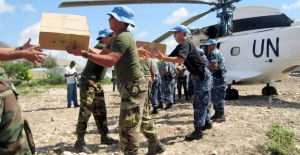Humanitarian aid shortfall reaches crisis point

Tropical storm Jeanne devastates Haiti
Photo: UN/Sophia Paris
The gap between humanitarian needs created by conflicts around the globe and the resources available to meet them continues to grow with relief agencies appealing for an extra $US16.4 billion to assist 57.5 million people in 22 countries in 2015.
The UN’s Office for the Coordination of Humanitarian Affairs has released an overview of the humanitarian outlook for 2015 which outlines the dire aid situation.
It cites three major crises in the Central African Republic, South Sudan and Syria which have dominated humanitarian response efforts and added to the burden in 2014.
These, in addition to Iraq, are the highest level crises declared by the humanitarian community and they will continue to require significant humanitarian assistance in 2015.
The overview says that the conflict in Syria has seen essential infrastructure damaged or destroyed, 191,000 people were killed and more than 12.2 million people require urgent assistance, including over five million children.
“Some 7.6 million people are internally displaced and another 3.2 million are refugees in neighbouring countries. Whilst the search continues for a political solution to the crisis, humanitarian organisations will do all they can to reach as many people as possible with life-saving assistance,” the overview says.
It says that in 2014, conflict and insecurity in Iraq displaced over 2.1 million people across the country. Some 5.2 million people are in need of aid, 2.2 million of them in areas under the control of the Islamic State of Iraq and the Levant (ISIL), where humanitarian agencies have little or no humanitarian access.
The outbreak of violence in South Sudan forced 1.9 million people to flee their homes in 2014. Close to 500,000 of these have sought refuge in neighbouring countries and 1.4 million are internally displaced. 1.5 million people are at risk of hunger, the overview says.
In the Central African Republic outbreaks of violence have prompted large-scale displacements of people and spikes in humanitarian needs.
A quarter of the population – or more than a million people – has either been displaced by the conflict within CAR or has been forced to flee across the borders.
Aside from these high-profile conflicts, long term crises caused by conflict, violence and natural disasters, including droughts and floods, mean that millions of people across the world will need humanitarian assistance in 2015 in the Democratic Republic of the Congo, Sudan, Afghanistan, Ukraine, Myanmar and elsewhere.
“Haiti and the Philippines are the only two countries in the appeals for 2014 which are no longer included in the global appeal for 2015,” the overview says.
“In Haiti, the Government, together with the UN and its partners, is preparing a Transitional Appeal (2015-2016) guiding both humanitarian action and resilience-building. In the Philippines, the Government announced the end of the humanitarian phase of the Haitian response on 4 July 2014.”
As the aid shortfall increases, humanitarian organisations continue to look at ways to become more effective and efficient.
“Improved needs assessment and analysis, strategic planning and prioritisation helped humanitarian organisations target their resources on the most vulnerable,” the overview says.
“Significant efforts are being made to ensure that the specific needs of women, children and other vulnerable groups are integrated into humanitarian response efforts. For example, in South Sudan camp coordinators and local NGO staff hold regular discussions with displaced people in camps to identify cases of harassment and sexual violence,” it says.
“As a result responses tailored to address these protection concerns have been incorporated in programs.”
Cesira Colleluori
AMES Staff Writer












